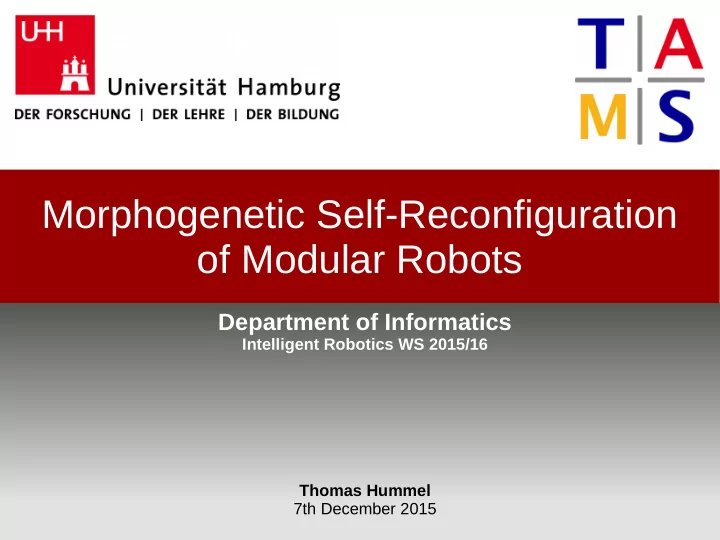

Morphogenetic Self-Reconfiguration of Modular Robots Department of Informatics Intelligent Robotics WS 2015/16 Thomas Hummel 7th December 2015
Outline ● Motivation / Introduction ● Background ● Applications ● Evaluation ● Conclusion 07/12/15 Outline 2
Modular Robotic Systems ● Robots with variable morphology – Reorganizing the connectivity of modules – Perform new tasks, adapt to new environments, recover from damage ● Consists of independent units : connect/disconnect Potentially more robust and more adaptive under dynamic environments 07/12/15 Introduction 3
Modular Robotic Systems – Classification Chain-based: ● Pro : scalable, easy motion planning ● Con : can't build complex 3D patterns http://www.iearobotics.com/wiki/images/4/48/Modular-snake-usar-1.jpg 07/12/15 Introduction 4
Modular Robotic Systems – Classification (cont.) Lattice-based: ● Pro : easy build of complex 3D patterns ● Con : complicated control and motion planning https://upload.wikimedia.org/wikipedia/commons/thumb/5/5c/The_Distributed_Flight_Array.jpg/800px-The_Distributed_Flight_Array.jpg 07/12/15 Introduction 5
Modular Robotic Systems – Classification (cont.) Hybrid approaches: ● Integrates advantages of chain and lattice based classes ● M-TRAN II + III, SUPERBOT, SMORES http://i.ytimg.com/vi/6ZdYjttytTo/maxresdefault.jpg 07/12/15 Introduction 6
Morphogenesis Morphogenesis = ''biological pattern formation'' https://mcb.berkeley.edu/labs/bilder/images/Morp http://www.livescience.com/images/i/000/037/15 hogenesis/Picture5.jpg 3/original/zebra.jpg 07/12/15 Morphogenetic Robotics 7
Gene Regulatory Networks (GRNs) [1] 07/12/15 Morphogenetic Robotics 8
What is Morphogenetic Robotics? [1] 07/12/15 Morphogenetic Robotics 9
Cross-Ball [4] 07/12/15 Cross-Ball 10
Cross-Ball: Hierachical Morphogenetic Model Chemical pattern formation Layer 1 Generate target pattern Physical pattern realization Layer 2 Generate reconfiguration plan Layer 3 Motion controlling Support module movement process 07/12/15 Cross-Ball 11
Layer 1: Chemical pattern formation [3] 07/12/15 Cross-Ball 12
Layer 1: Chemical pattern formation (cont.) Change of v-cell density in grid i : dn i dt = r ⋅ n i ( N − n i )− d ⋅ K i ⋅ M i − a ⋅ ρ i + ∑ rec n k n i +ρ i k K i = [k i up , k i down , k i left , k i right , k i forward , k i backward ] T M i = [m i up , m i down , m i left , m i right , m i forward , m i backward ] T N : maximum number of v-cells in the grid K i : dispersal control vector M i : density gradient vector ρ i : ECM-value (environmental constraint) r,d,a : predefined constants [3] 07/12/15 Cross-Ball 13
Layer 1: Chemical pattern formation (cont.) Change of ECM value in grid i: d ρ i dt =− b ⋅ n i + e ⋅ ∑ f ji ( n j ) n i +ρ i j f ji (n j ): function rules depend on desired pattern (e.g. vehicle pattern) b,e : predefined constants Morphogen level of grid i = ∆( n i , ρ i ) [3] 07/12/15 Cross-Ball 14
Layer 2: Physical pattern realization ● Target pattern known ● State transitions controlled by a GRN model: – Attracting gene-protein pair ( g A , p A ) – Repelling gene-protein pair ( g P , p P ) [3] ● Modules with a higher morphogen level are more likely to attract other modules ● Modules with a lower morphogen level are more likely to be repelled 07/12/15 Cross-Ball 15
Layer 3: Motion controlling ● Evaluate self-reconfiguration plan generated from layer 2 controller ● Hardware-specific controller ● Introducing skeleton modules and allow modules to work in groups [4] Reducing complexity of searching process on the module movement plan 07/12/15 Cross-Ball 16
https://www.youtube.com/watch?v=z9yemQJtyQg 07/12/15 Cross-Ball 17
M-TRAN III Modular Transformer III : ● Developed by AIST and Tokyo-Tech (since 1998) ● Hybrid design http://www.tech-blog.pl/wordpress/wp- https://unit.aist.go.jp/is/frrg/dsysd/mtran3/ content/uploads/2008/05/modular-robot_m-tran.jpg mtran123.jpg 07/12/15 M-TRAN III 18
M-TRAN III (cont.) Module Control: ● Centralized or distributed ● Communication via bus → Controller Area Network (CAN) [2] 07/12/15 M-TRAN III 19
https://www.youtube.com/watch?v=4oSavAHf0dg 07/12/15 M-TRAN III 20
Comparison of Cross-Ball and M-TRAN III Cross-Ball M-TRAN III ● Hybrid design ● Hybrid design Design Experiments - Embodied simulation environment + Physical prototype ● Bio-inspired approach using the ● Distributed controller and global Controlling mechanism theory of morphogenesis with communication using a network GRNs bus + Completely independent modules ● Mostly independent modules - No autonomous self- + Fully autonomous self- Autonomy reconfiguration (target pattern reconfiguration. dependent on predefined function). ● Successful simulation using 27 ● Successful experiments using 24 Scalability modules modules - Limited by global bus and ID + Theoretically no limitations numbering (max. 50 modules) 07/12/15 Comparison 21
Conclusion Advantages ● Modularity reduces cost of design, manufacturing, maintenance ● Easy adaptation to changes in the environment ● Robust to system failures, malfunctions ● Ability for self-repairing ● Hierarchical framework almost completely generic Future work ● Build and evaluate physical design ● Simplify controllers to further reduce complexity and computational costs 07/12/15 Conclusion 22
Questions? Thank you for your attention! 07/12/15 Conclusion 23
Literature [1] Jin, Y., & Meng, Y. (2011). Morphogenetic robotics: An emerging new field in developmental robotics. Systems, Man, and Cybernetics, Part C: Applications and Reviews, IEEE Transactions on, 41(2), 145-160. [2] Kurokawa, H., Tomita, K., Kamimura, A., Kokaji, S., Hasuo, T., & Murata, S. (2008). Distributed self-reconfiguration of M-TRAN III modular robotic system. The International Journal of Robotics Research, 27(3-4), 373-386. [3] Meng, Y., Zhang, Y., & Jin, Y. (2011). Autonomous self-reconfiguration of modular robots by evolving a hierarchical mechanochemical model. Computational Intelligence Magazine, IEEE, 6(1), 43-54. [4] Meng, Y., Zhang, Y., Sampath, A., Jin, Y., & Sendhoff, B. (2011, May). Cross-ball: a new morphogenetic self-reconfigurable modular robot. In Robotics and Automation (ICRA), 2011 IEEE International Conference on (pp. 267-272). IEEE. 07/12/15 Literature 24
Recommend
More recommend